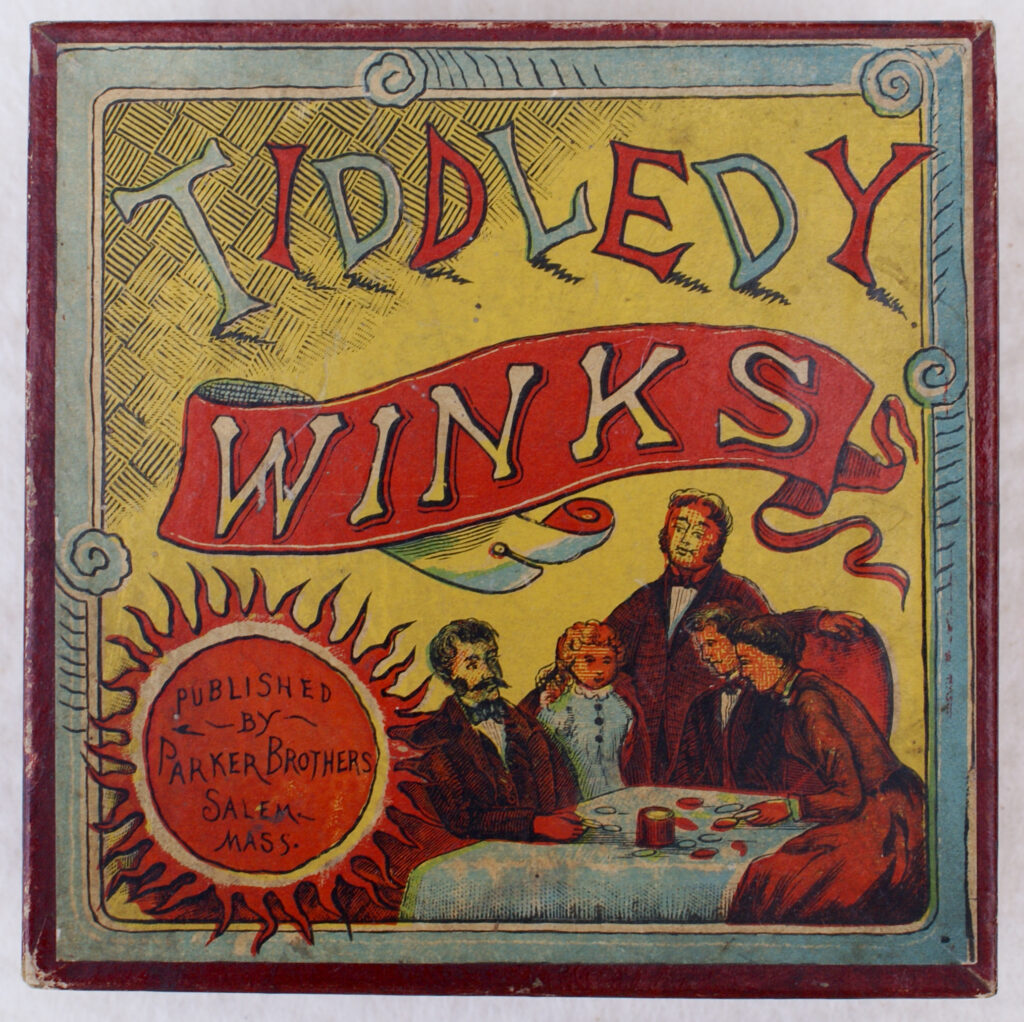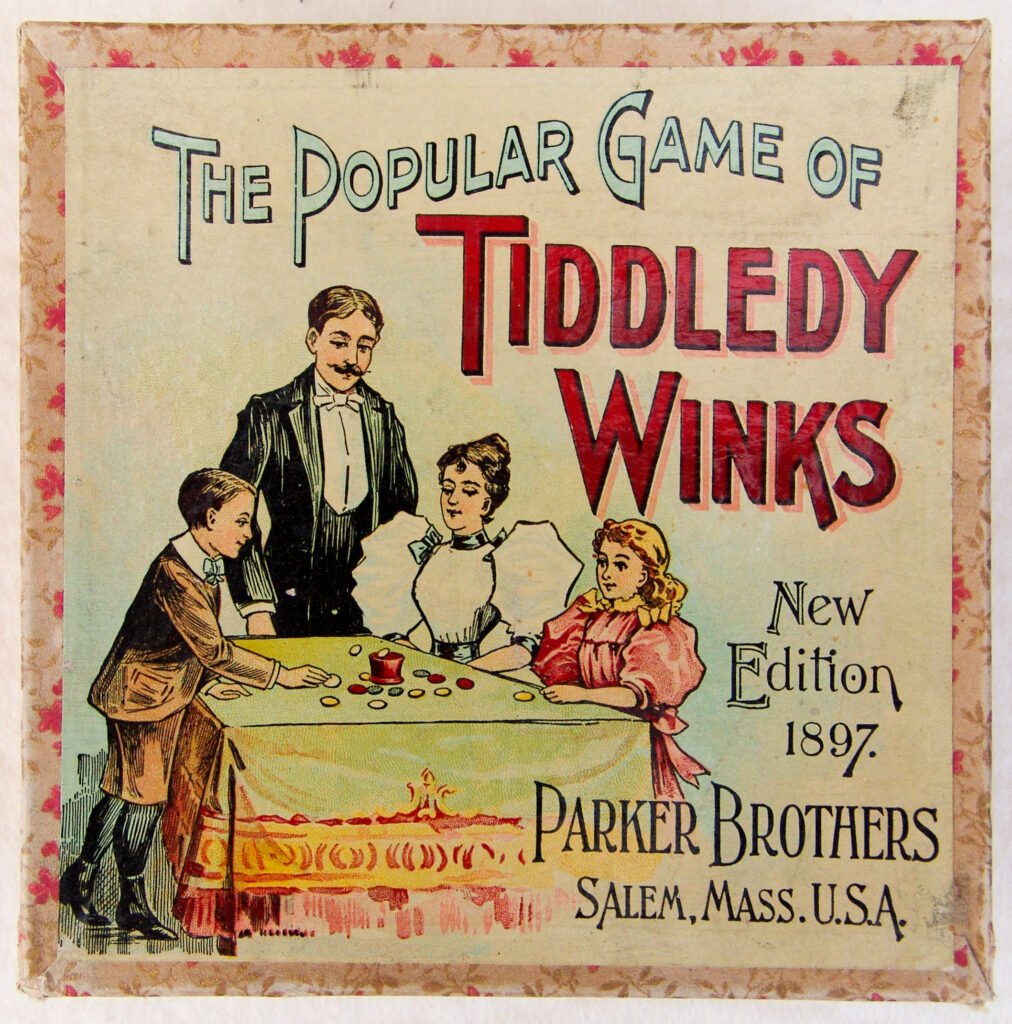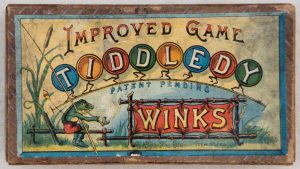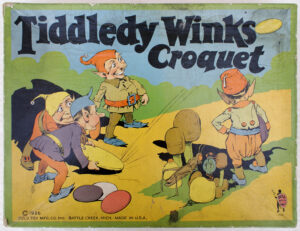The Adult Party Game
Photographs of people playing tiddlywinks in the 1890s are hard to come by. Cabinet card photographs are the form most likely found in this era. People in the photographs were ordinarily asked by the photographers not to smile, since smiling would likely result in blurry photographs due to the slow film speeds available at the time.
In the early 1890s, tiddlywinks was principally an adult game, and parties were held to play Progressive Tiddledy Winks (mentioned in the Young Folks Cycloædia, 7 November 1890). The Parker Brothers Progressive party edition (© 1891) contained 4 full sets, scorecards, and gold, silver, and red stars. In this game,
partners who win at the head table each place a gold star upon their score cards. Partners who lose at the booby table place a red star upon their score cards. Partners who progress at any of the tables each place a silver star upon their cards. […] Royal, Progressive, and Booby prizes may be awarded to those having the largest number of respective stars.
Parker Brothers • Progressive Tiddledy Winks • rules • © 1891 • Tucker Tw ID - PBR-19
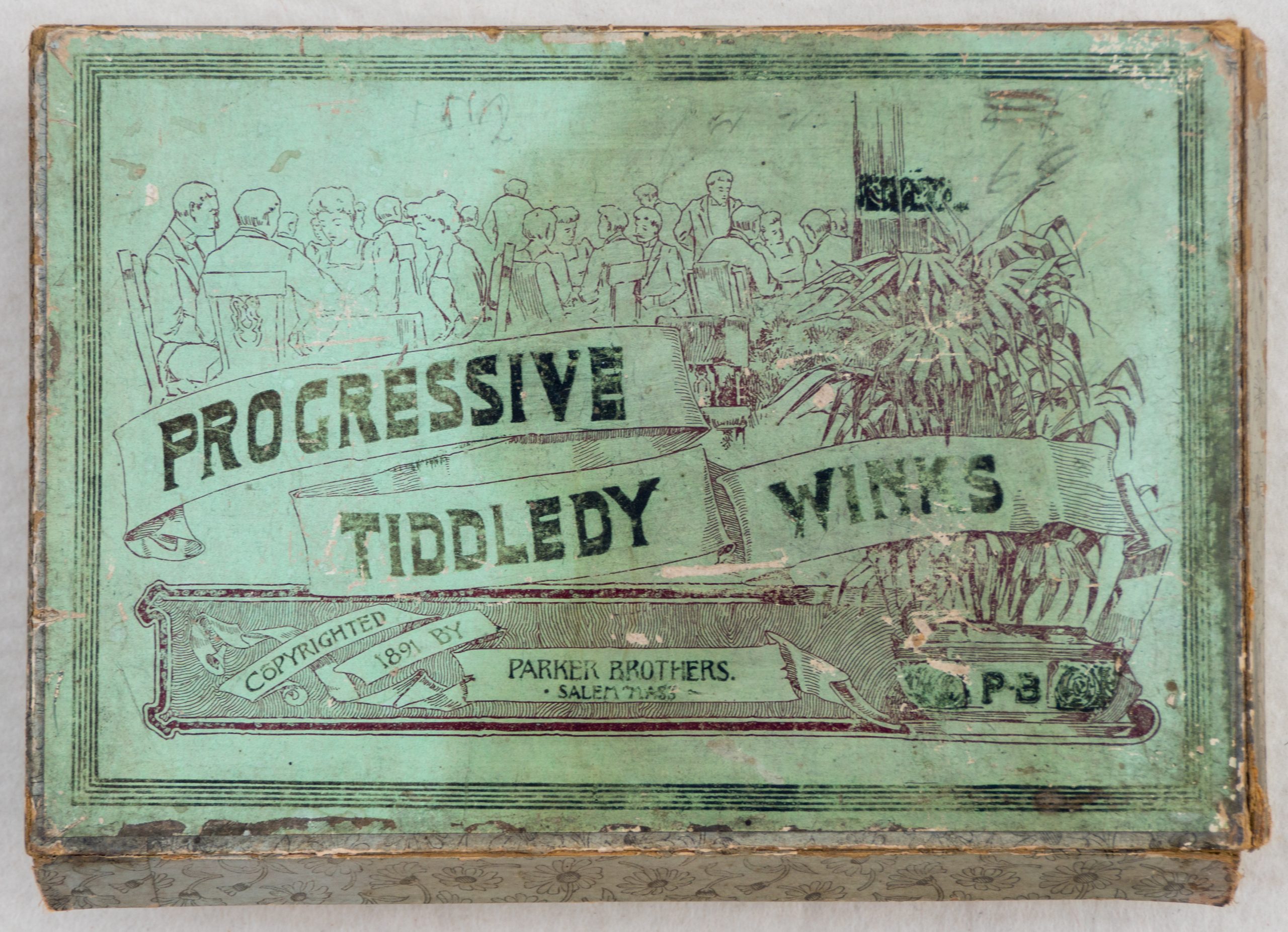
Rick Tucker Tiddlywinks Collection
Licenseable per Creative Commons CC BY-SA 4.0
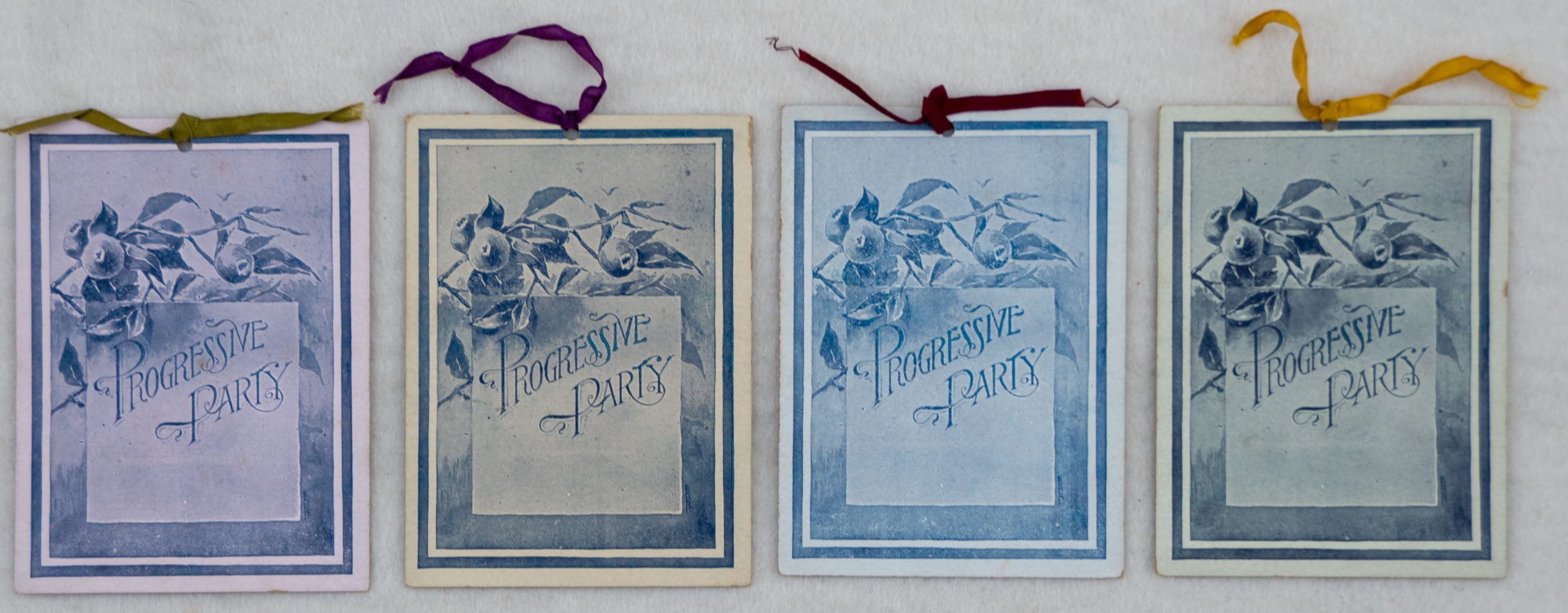
Rick Tucker Tiddlywinks Collection
Licenseable per Creative Commons CC BY-SA 4.0
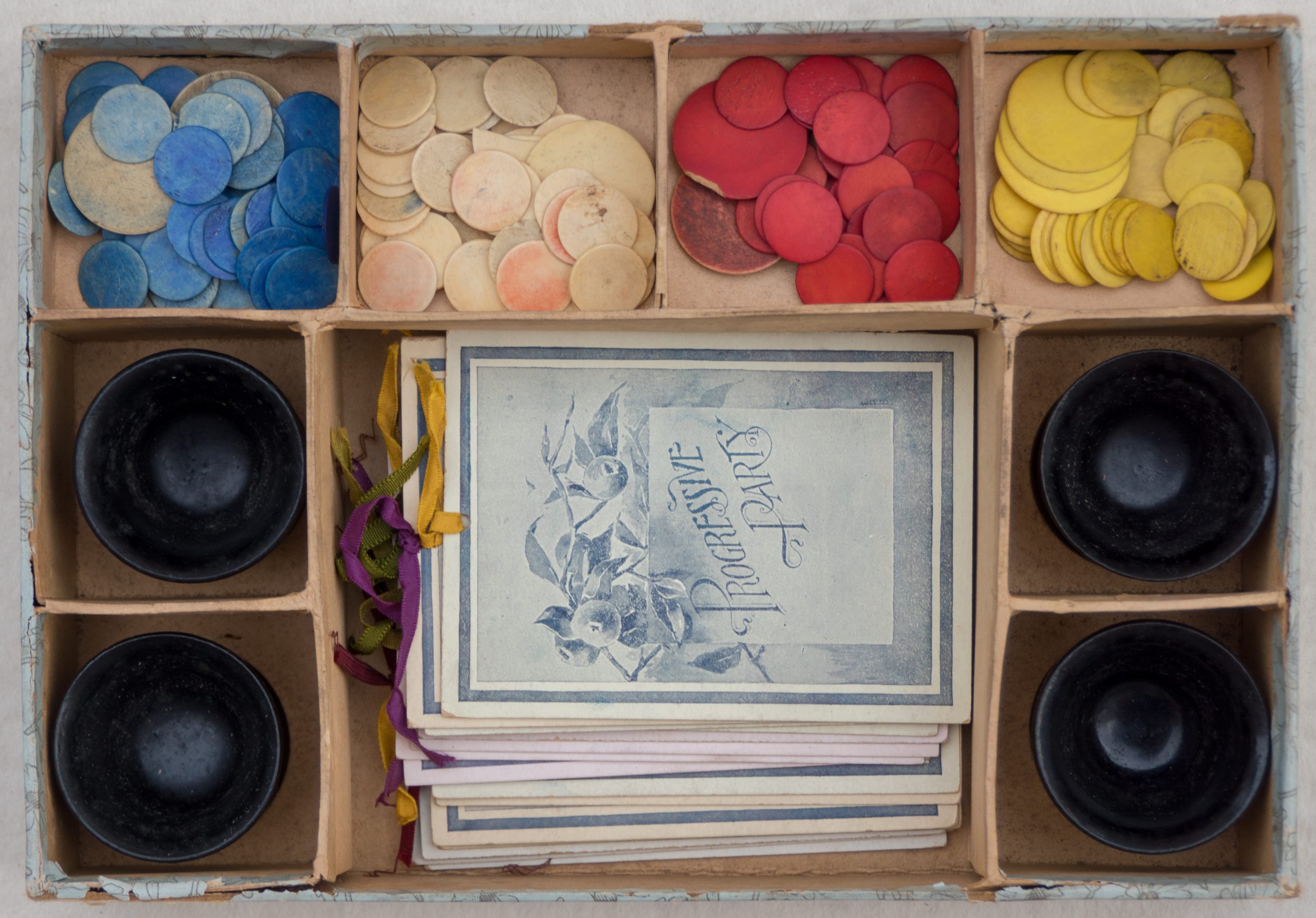
Rick Tucker Tiddlywinks Collection
Licenseable per Creative Commons CC BY-SA 4.0
Parker Brothers also published PROGRESSIVE HOP SCOTCH TIDDLEDY WINKS, which is marked with an 1891 copyright and Patent Applied For. The game cover depicts 3 tables with competing adults playing at tables, with onlookers, along with children competing on the floor.
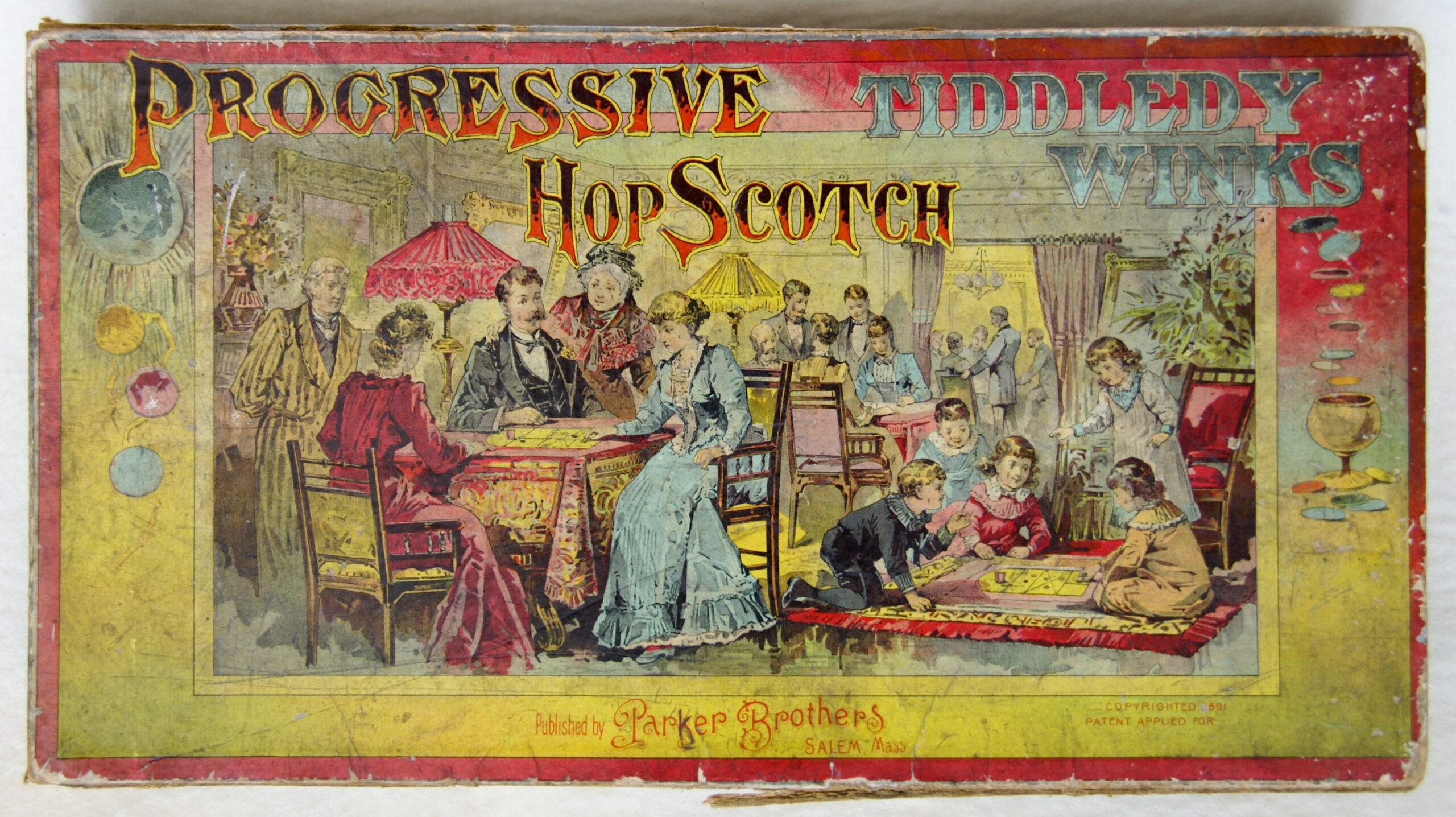
title • PROGRESS HOP SCOTCH TIDDLEDY WINKS
publisher • Parker Brothers (Salem, Massachusetts)
date • © 1891 (on cover)
item • game cover
photograph by • Rick Tucker
original in • Tucker Tiddlywinks Collection
licenseable per Creative Commons CC BY-SA 4.0
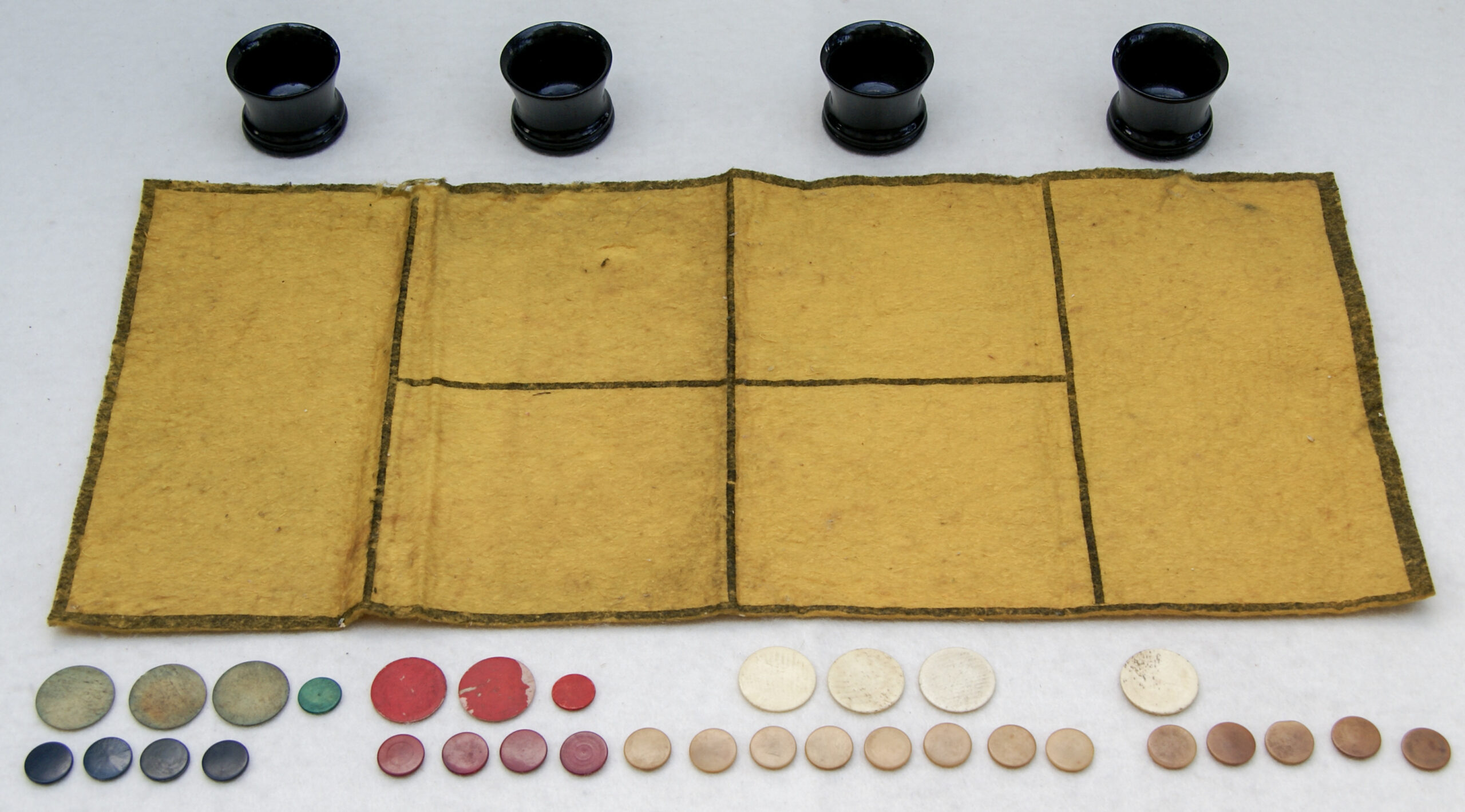
title • PROGRESS HOP SCOTCH TIDDLEDY WINKS
publisher • Parker Brothers (Salem, Massachusetts)
date • © 1891 (on cover)
item • contents
photograph by • Rick Tucker
original in • Tucker Tiddlywinks Collection
licenseable per Creative Commons CC BY-SA 4.0
McLoughlin Bros. also sold a Progressive Tiddledy Winks set, which was sold for $3.00 according to an ad in The American Stationer (19 February 1891). McLoughlin copyrighted “Progressive Tiddledy Winks, Rules and Suggestions” on 7 March 1891.
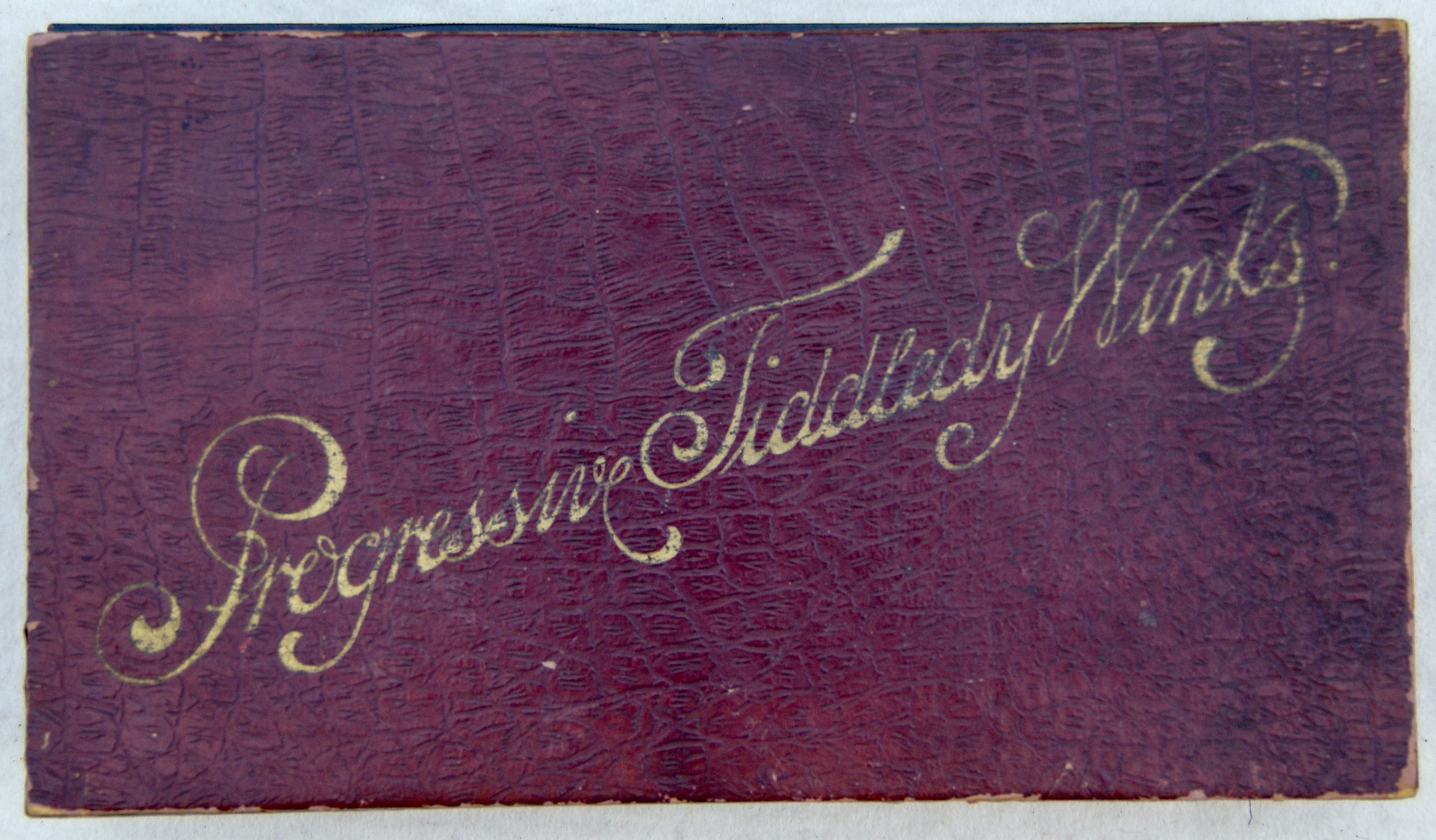
Rick Tucker Tiddlywinks Collection
Licenseable per Creative Commons CC BY-SA 4.0
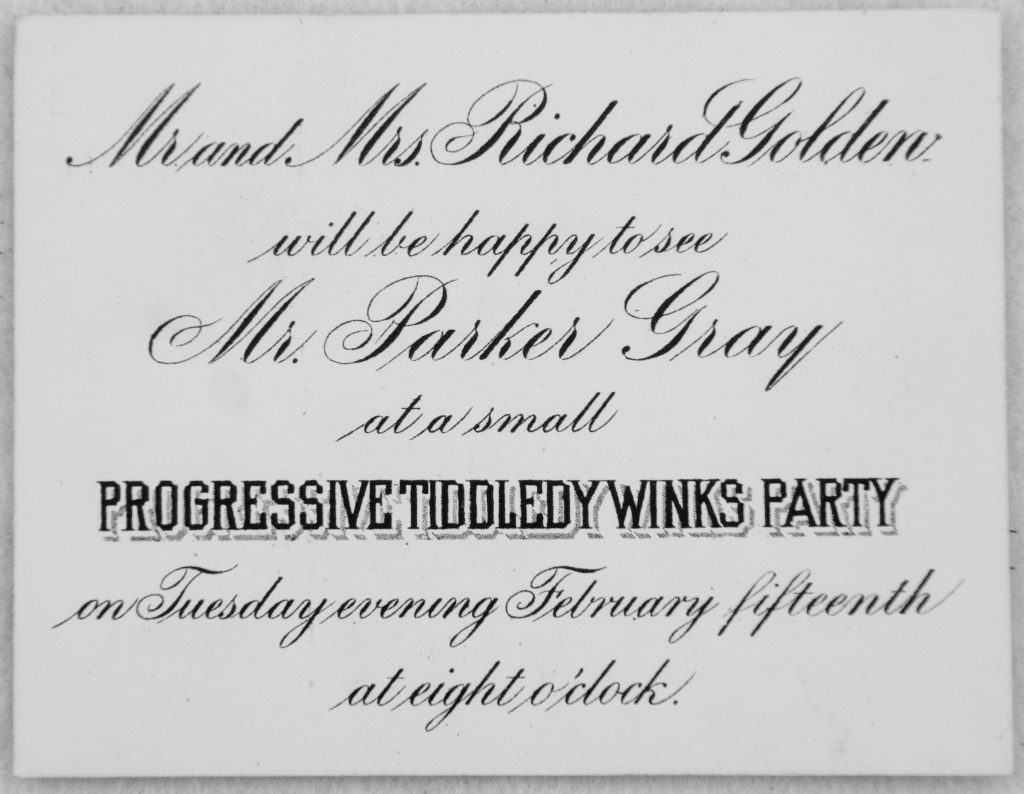
Rick Tucker Tiddlywinks Collection
Licenseable per Creative Commons CC BY-SA 4.0
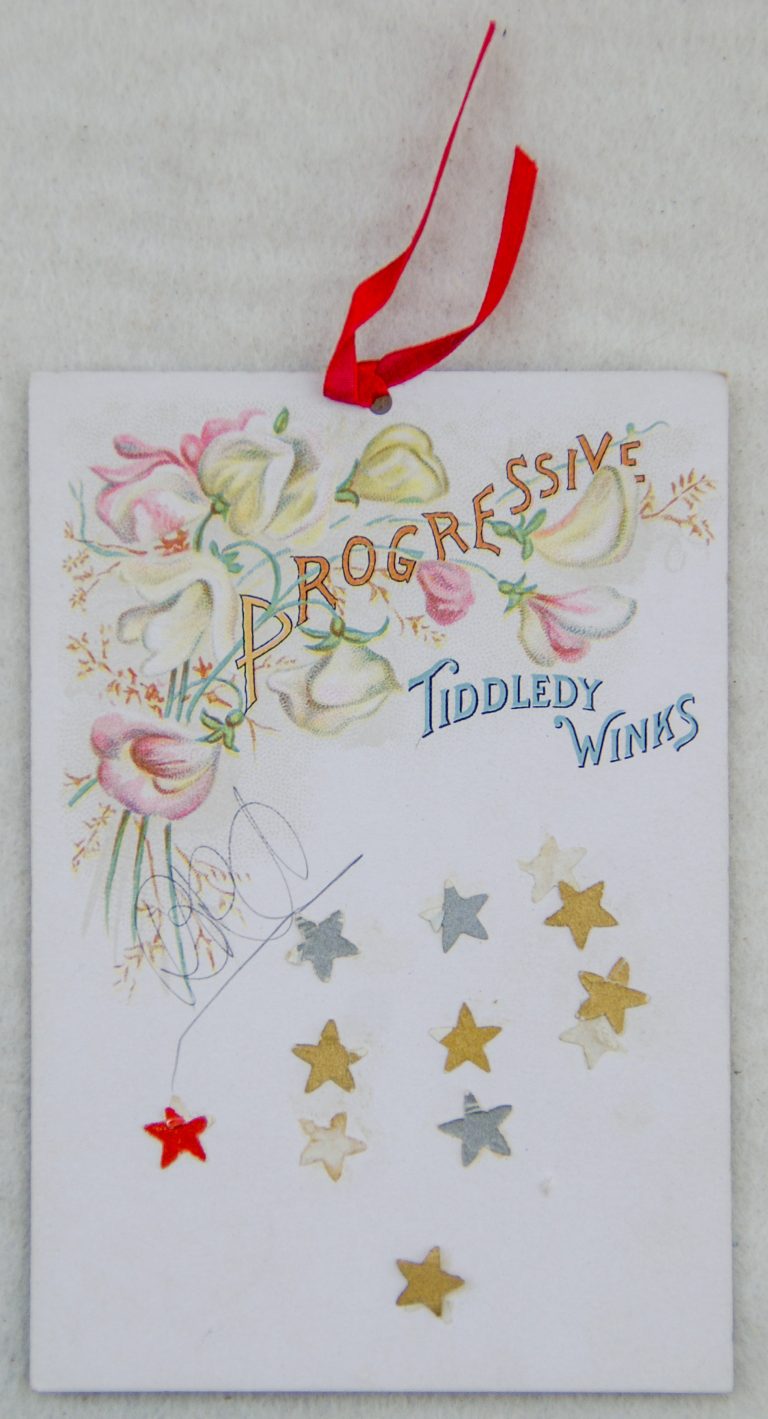
Rick Tucker Tiddlywinks Collection
Licenseable per Creative Commons CC BY-SA 4.0
And from correspondence of Lady Emily Lutyens (1874–1964; granddaughter of well-known author, Edward Bulwer-Lytton), writing in her diary entry on 24 April 1892 at the age of 17:
![[+template:(Tucker Tw ID • [+xmp:title+] — publisher • [+iptc:source+] — title • [+xmp:headline])+]](https://tiddlywinks.org/wp-content/uploads/2022/11/1953-by-Emily-Lutyens-title-A-Blessed-Girl-item-book-cover.jpeg)
After dinner we all played the most exciting game that ever was invented, called Tiddleywinks. It consists in flipping counters into a bowl, and being a good number we played at two tables, one table against another, and the excitement was tremendous. I assure you everyone’s character changes at Tiddleywinks in the most marvelous way. To begin with, everyone begins to scream at the top of their voices and to accuse everyone else of cheating. Even I forgot my shyness and howled with excitement. Con darted aroung the room snatching at counters, screaming and trembling with excitement. Lord Wolmer flicked all the counters off the table and cheated in every possible way. George was very distressed at this and conscientiously picked every counter up again. Even Gerald got fearfully excited and was quite furious because someone at his table knocked over the bowl just as all the counters were in. […] I assure you no words can picture either the intense excitement or the noise. I almost scream in describing it. [28]
Emily Lytton Lutyens, A Blessed Girl, © 1953
Emily Lutyens’ husband, Edwin Lutyens (1869–1944), an architect, designed the Cenotaph in Whitehall, London and other prominent buildings.
Evolving to a Children's Game
Many of the early tiddlywinks sets show adults playing, such as those by Chaffee and Selchow (1899) and The Interesting Game of Mumbly Peg (made by The American Toy Airship Company).
![[+template:(Tucker Tw ID • [+xmp:title+] — publisher • [+iptc:source+] — title • [+xmp:headline])+]](https://tiddlywinks.org/wp-content/uploads/2022/07/ATA-01-cover-DSC09671-2-3-1024x1021.jpg)
Rick Tucker Tiddlywinks Collection
Licenseable per Creative Commons CC BY-SA 4.0
![[+template:(Tucker Tw ID • [+xmp:title+] — publisher • [+iptc:source+] — title • [+xmp:headline])+]](https://tiddlywinks.org/wp-content/uploads/2022/07/ATA-01-shooting-quoit-at-target-DSC09679-2-1024x832.jpg)
squidging a quoit wink at the circular numbered target
Rick Tucker Tiddlywinks Collection
Licenseable per Creative Commons CC BY-SA 4.0
One of the most common 1890s series of tiddlywinks sets are the Parker Brothers THE POPULAR GAME OF TIDDLEDY WINKS and similar editions, all with 4 or more people shown playing at a table on the cover. This series reveals an interesting sociological trend: the evolution of tiddlywinks from a predominantly adult game to one mostly aimed at children. The earlier Parker sets in my collection (shown below) depict adults playing winks and a perhaps a child watching. Later sets show two adults watching as two children (boy and girl) play (one of these was sold by Sears in its catalog as late as 1919).
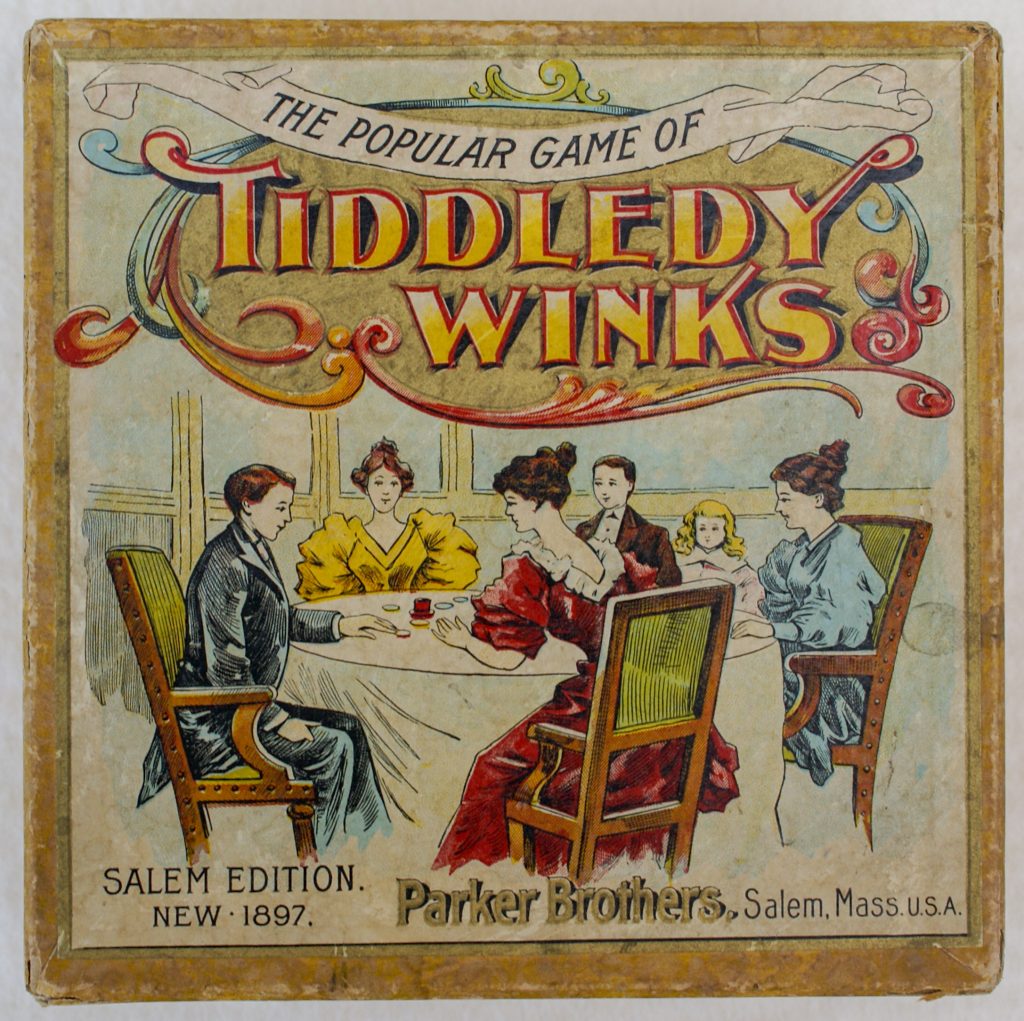
Rick Tucker Tiddlywinks Collection
Licenseable per Creative Commons CC BY-SA 4.0
![[+template:(Tucker Tw ID • [+xmp:title+] — publisher • [+iptc:source+] — title • [+xmp:headline])+]](https://tiddlywinks.org/wp-content/uploads/2022/09/1890s-3-women-1-man-playing-tiddledy-winks-at-table-4-women-standing-cabinet-card-D-Cramer-Vance-Street-Carey-OH-adj-676x1024.jpg)
![[+template:(Tucker Tw ID • [+xmp:title+] — publisher • [+iptc:source+] — title • [+xmp:headline])+]](https://tiddlywinks.org/wp-content/uploads/2022/09/1890s-Three-women-playing-tiddledy-winks-at-small-table-two-standing-cabinet-card-Hyatt-Tooke-Cortland-NY-DSC07631.JPG-adj-1024x681.jpg)
![[+template:(Tucker Tw ID • [+xmp:title+] — publisher • [+iptc:source+] — title • [+xmp:headline])+]](https://tiddlywinks.org/wp-content/uploads/2022/09/1893-Two-men-and-one-woman-playing-tiddledy-winks-on-small-table-with-gas-light-cabinet-card-studio-WPCornell-Toronto-front-adj-1024x667.jpg)

